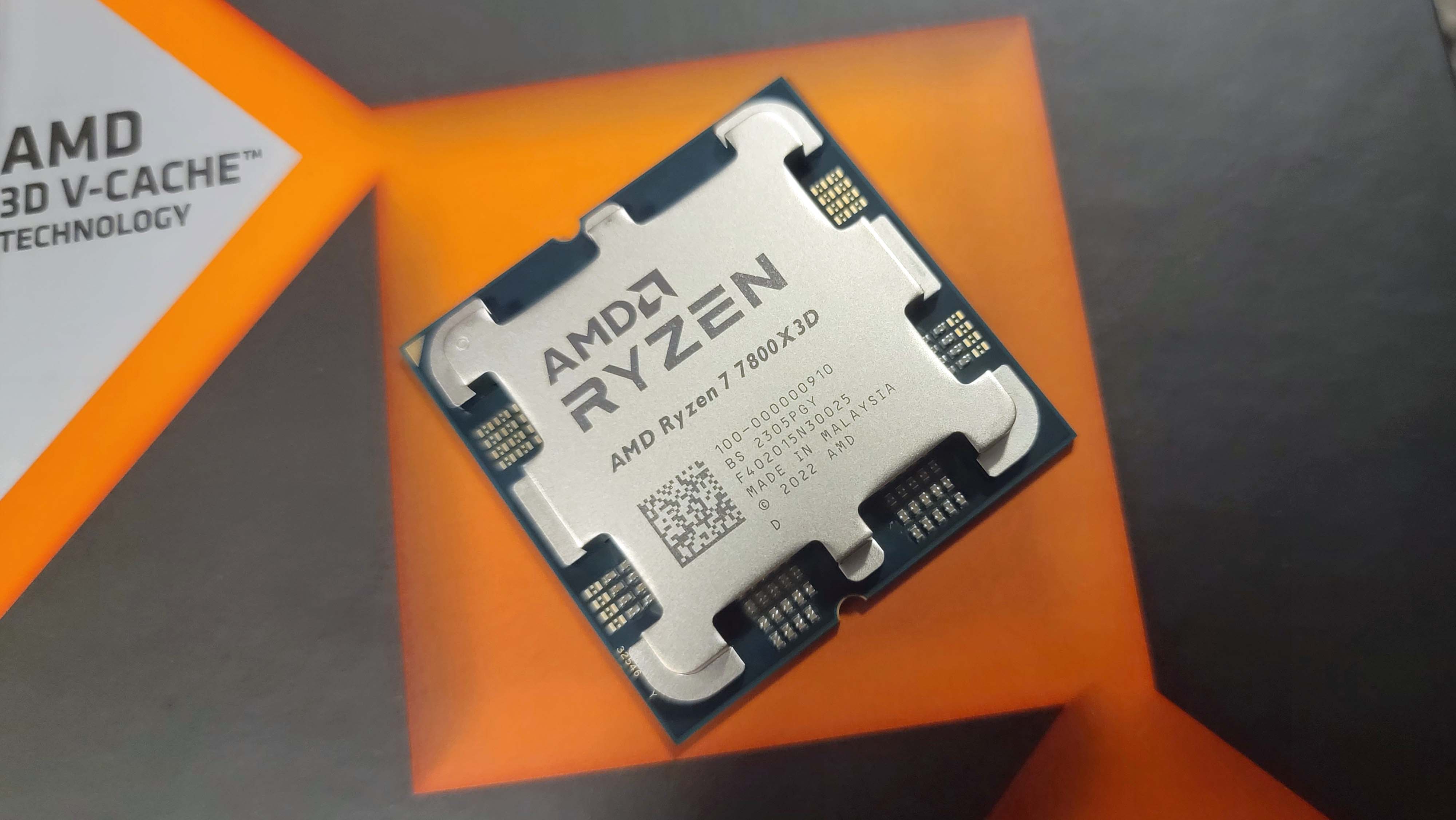Why you can trust Tom's Hardware
AMD Ryzen 7 7800X3D Power Consumption and Efficiency
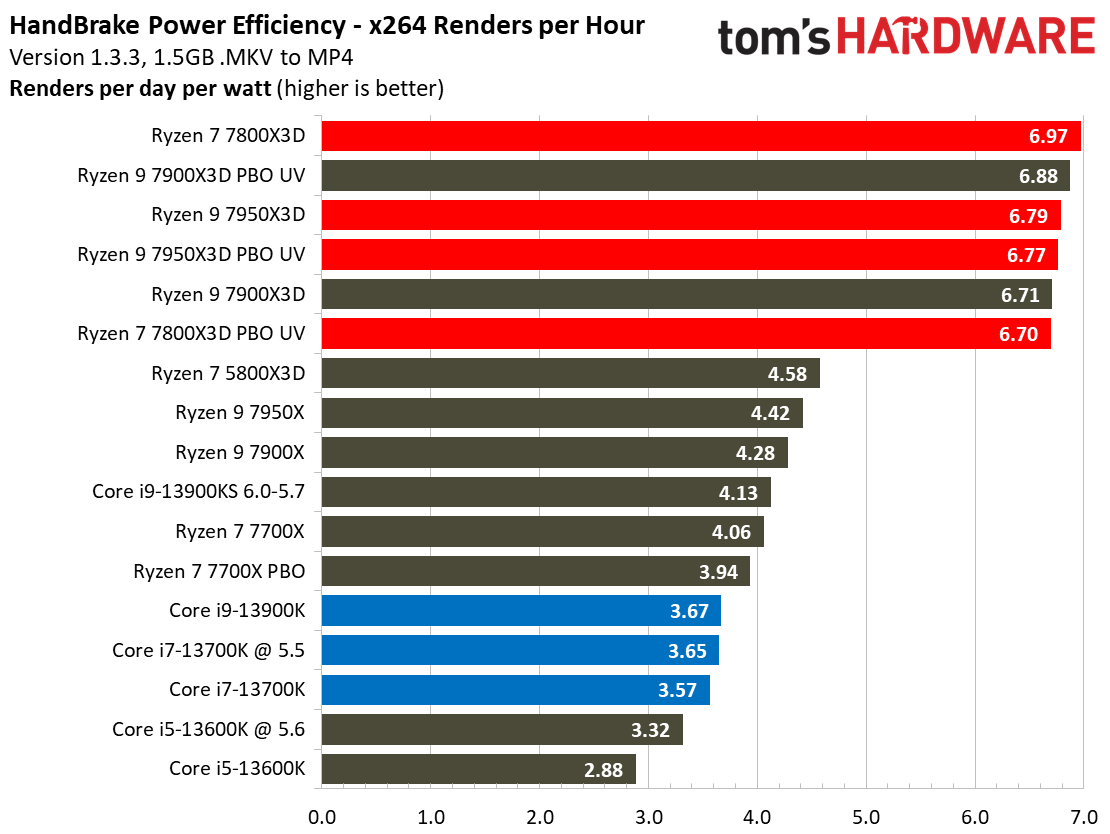
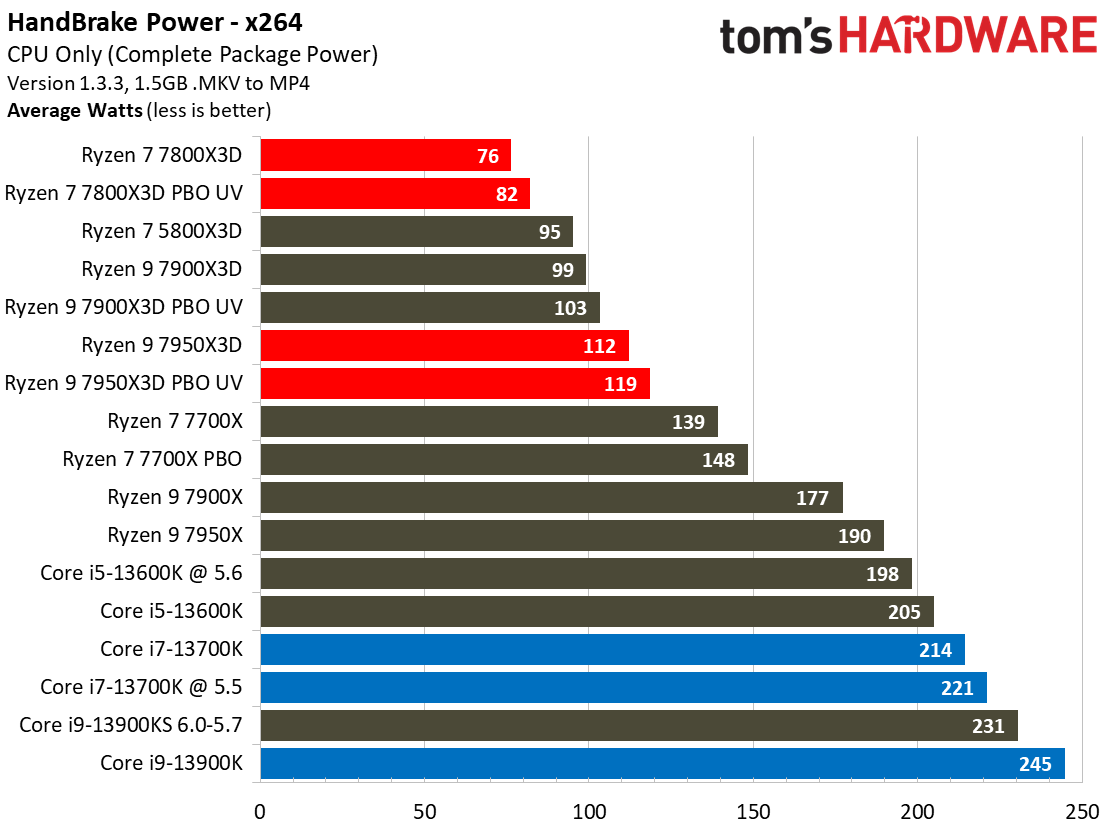
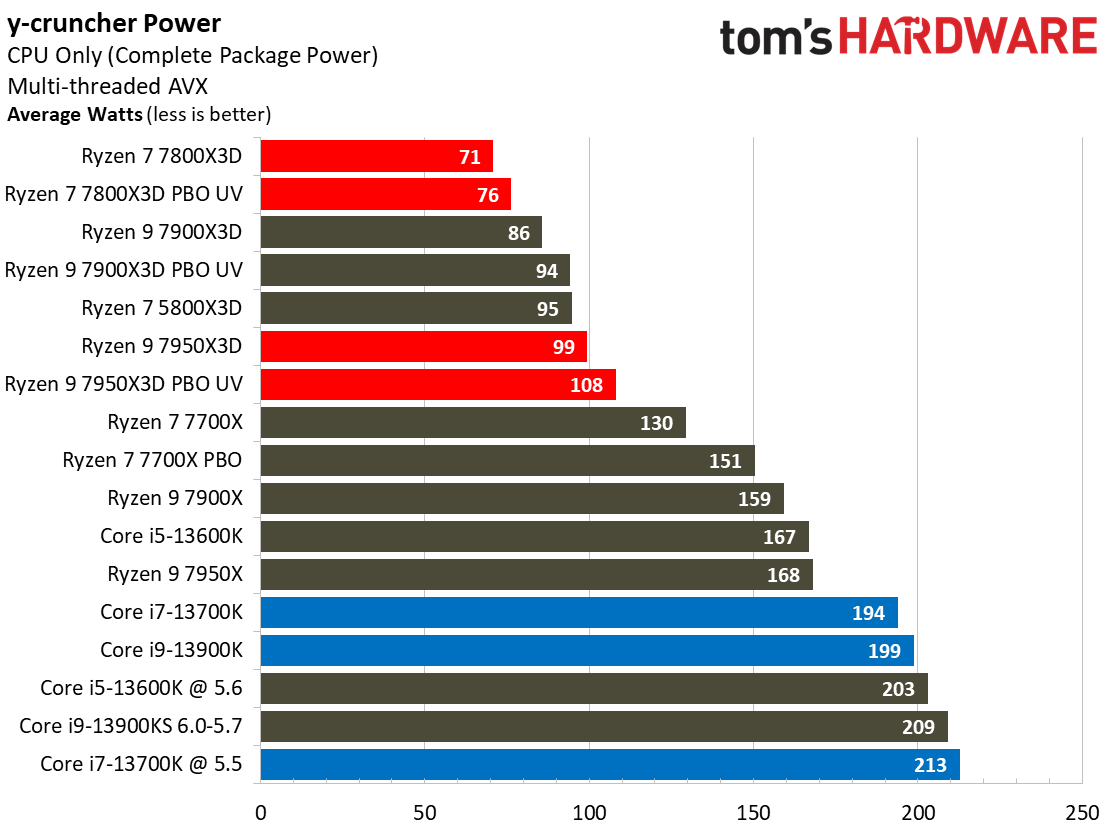
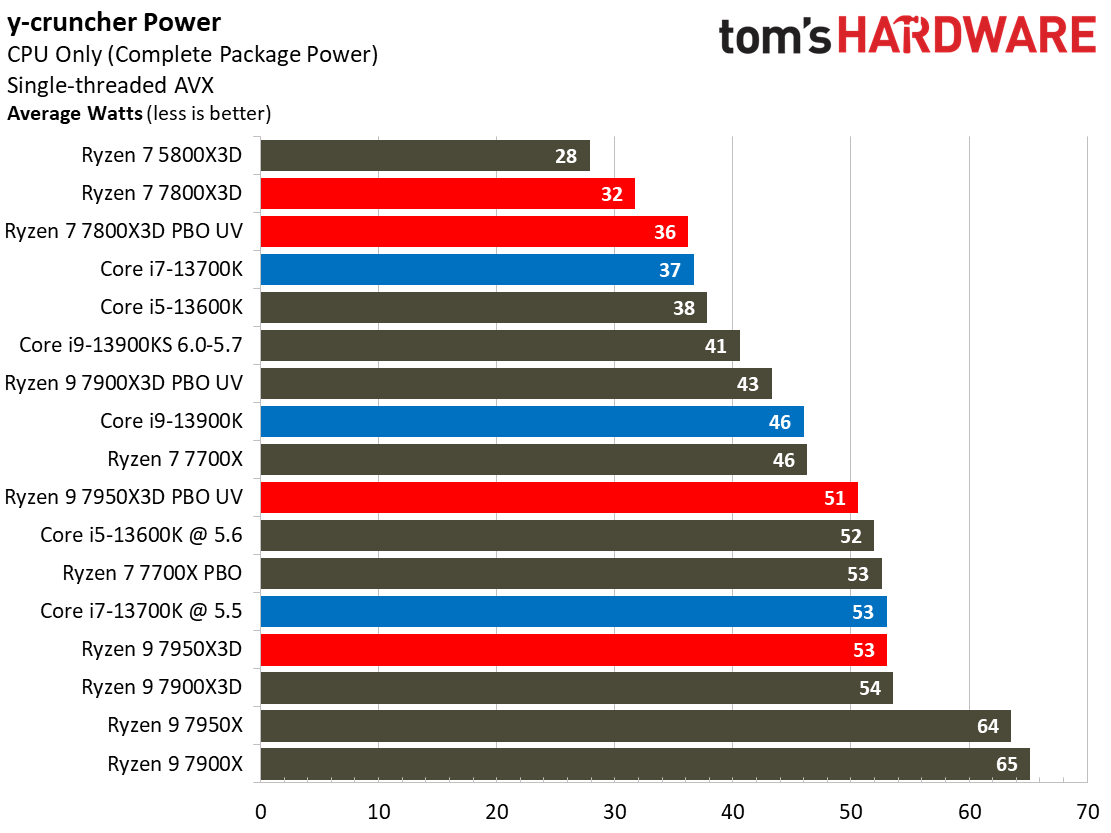
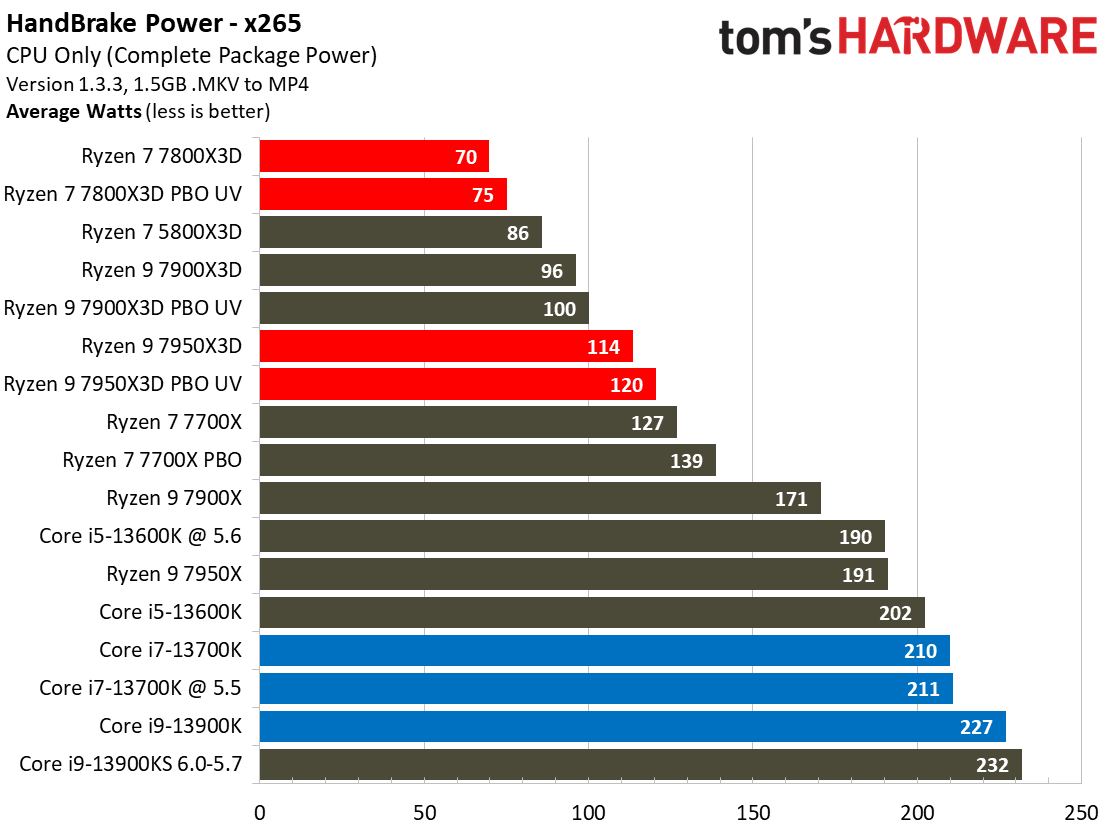
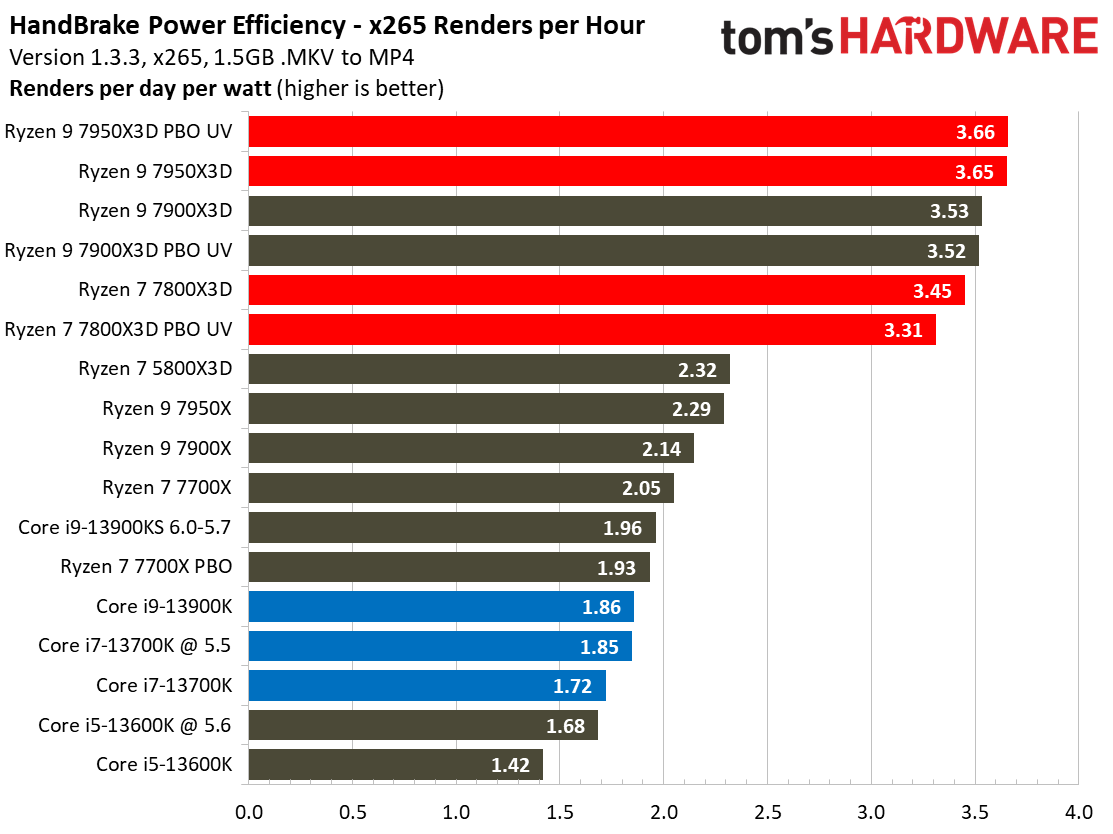
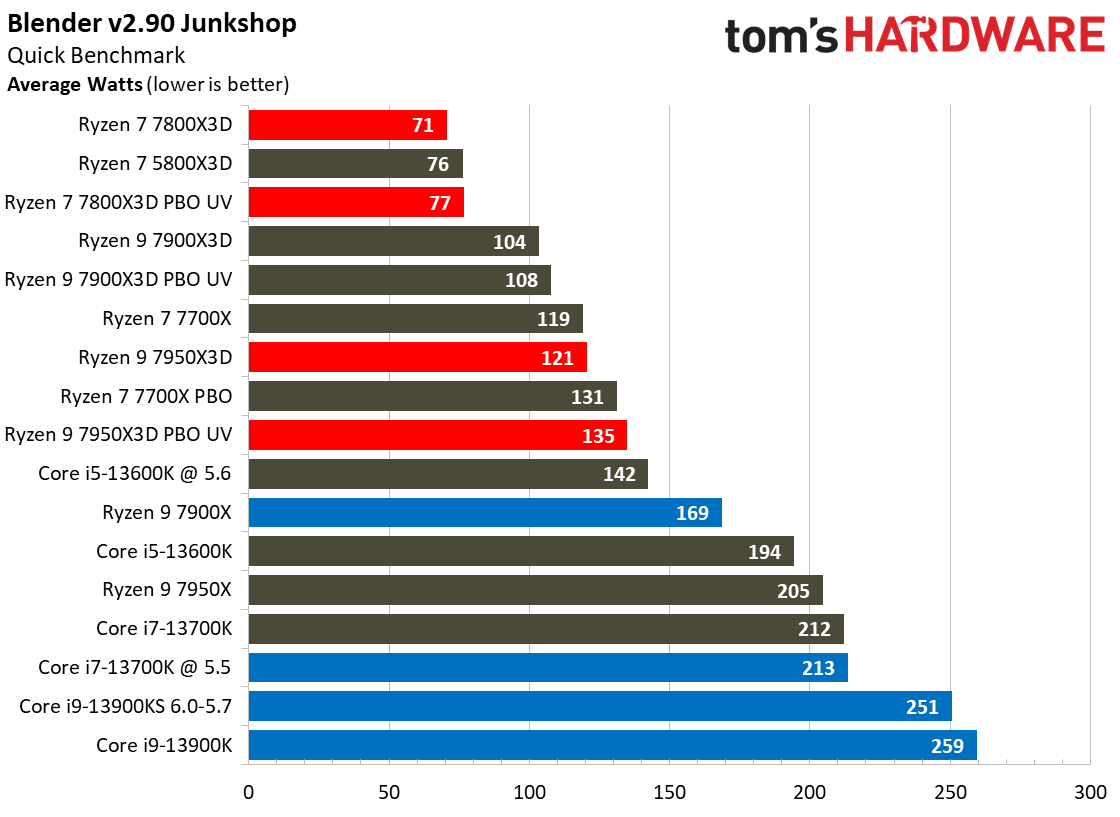

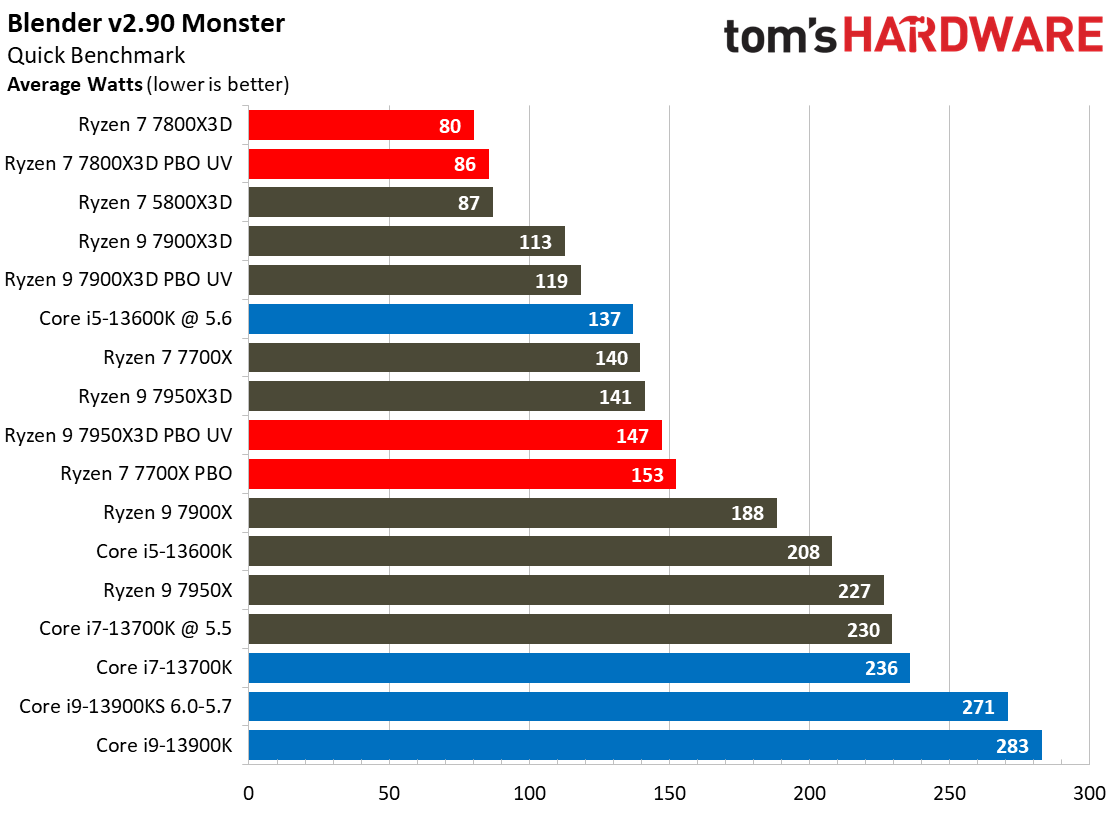
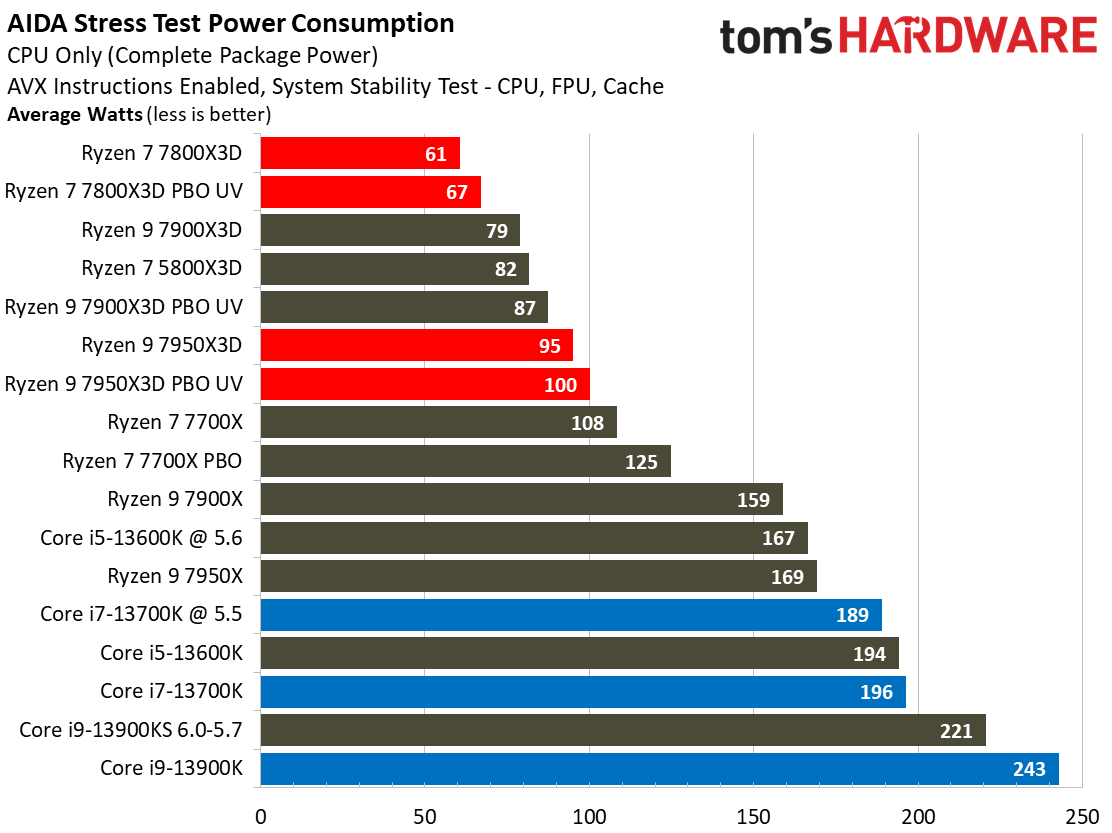
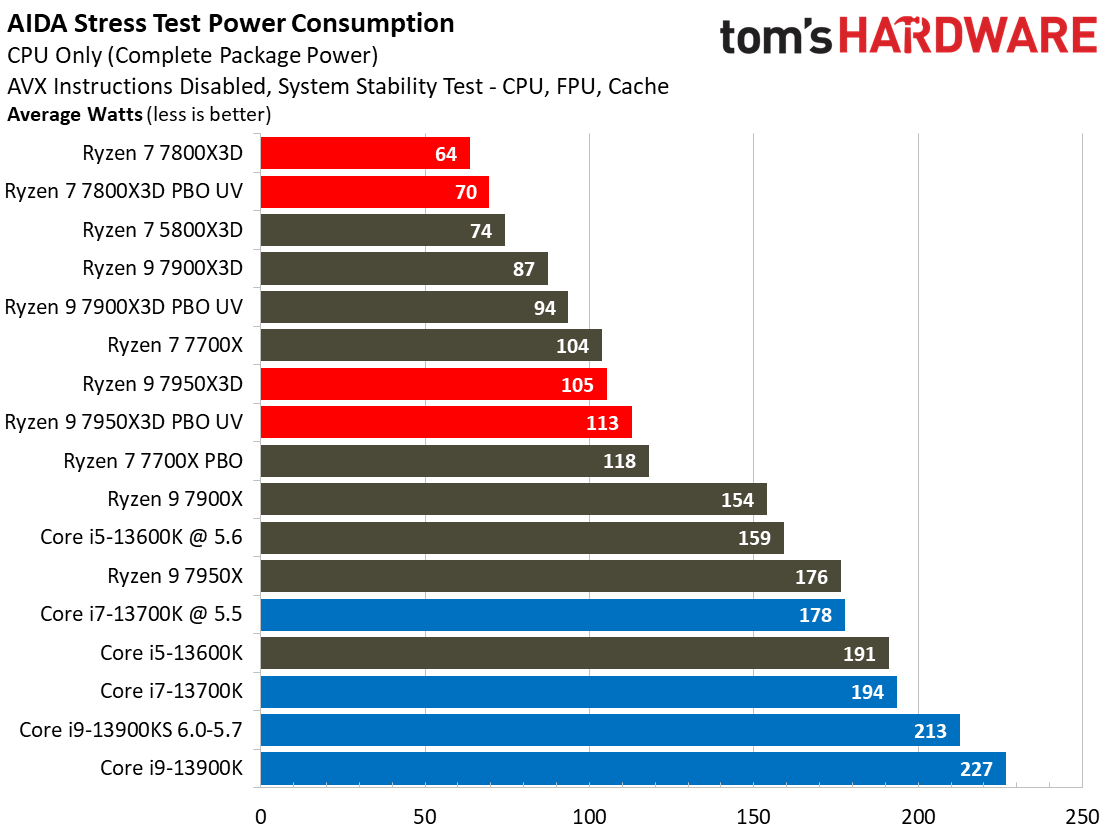
AMD's Ryzen chips have excellent power and efficiency metrics, but the Ryzen 9 7000X3D chips are even more efficient because of their constrained power metrics. AMD has spec'd a higher 120W TDP rating for the 7800X3D, but it appears to be running closer to the 65W TDP envelope, which has a maximum of 88W of power consumption, during normal use. You can see this measured in more detail on the following page. This means the chip is basically operating in Eco Mode, which confers massive power consumption and efficiency benefits.
Ryzen’s Eco Mode allows you to downshift AMD processors into lower TDP envelopes with a single click in the BIOS or Ryzen Master software, thus yielding lower power consumption and heat. This also improves efficiency tremendously. We can see those same benefits reflected in the Handbrake renders-per-watt efficiency metric for the X3D chips. Again, the X3D chips top this chart by vast margins, but the Ryzen 7 7800X3D leads overall due to the benefits of its power-sipping single-chiplet design.
Our highest average power measurement for the Ryzen 7 7800X3D was 86W, showing that it runs well below the rated 120W TDP.
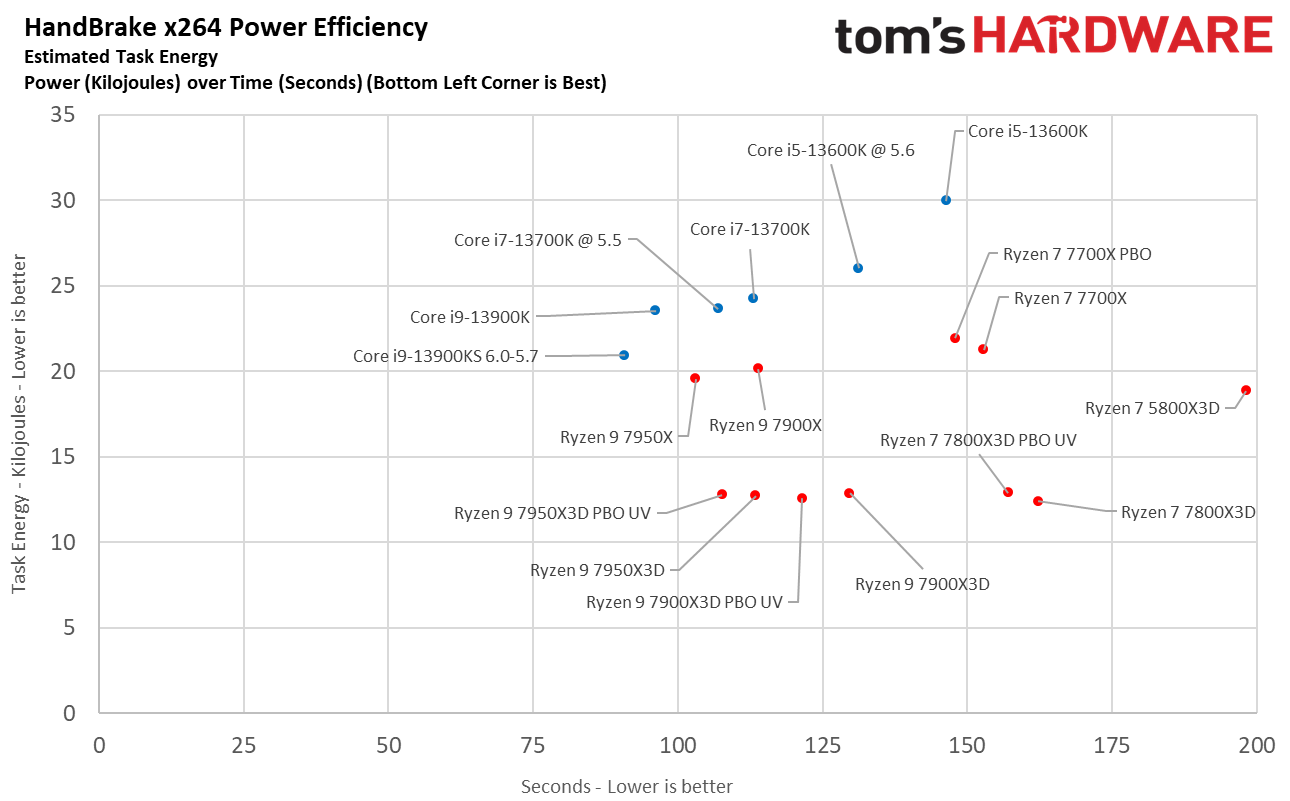
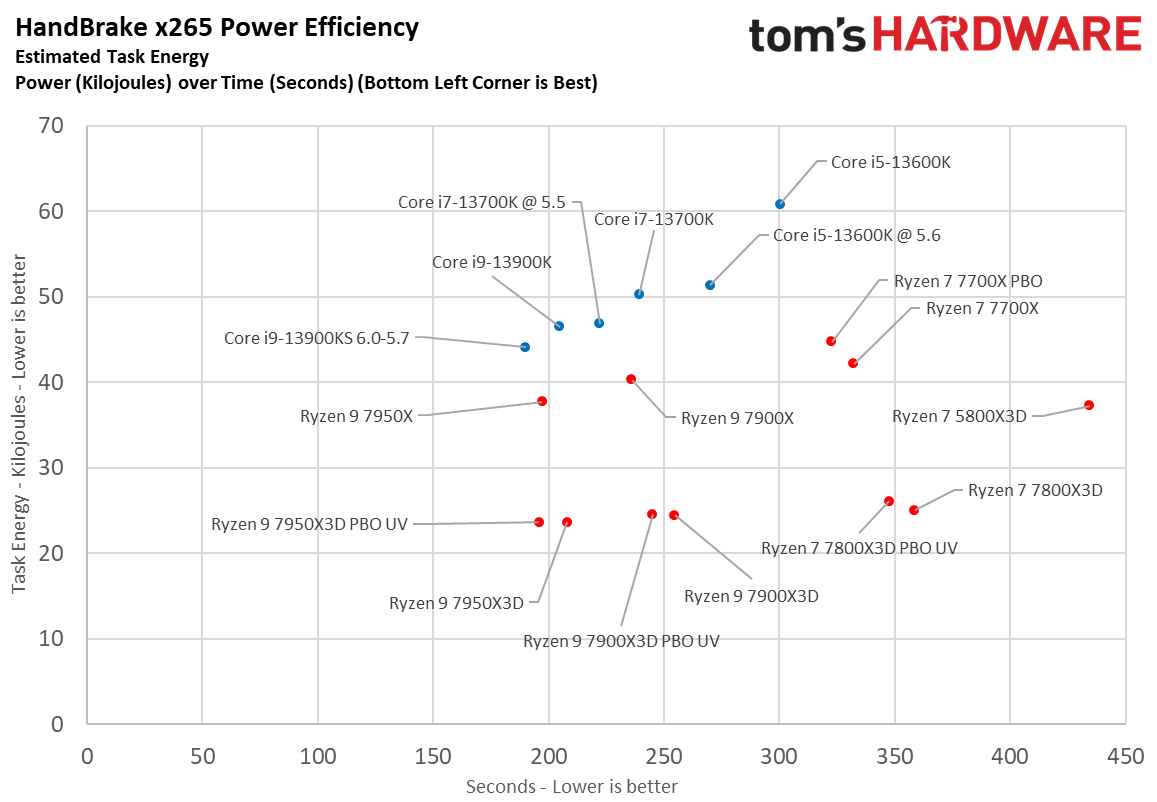
Here we take a slightly different look at power consumption by calculating the cumulative energy required to perform x264 and x265 HandBrake workloads, respectively. We plot this 'task energy' value in Kilojoules on the left side of the chart.
These workloads are comprised of a fixed amount of work, so we can plot the task energy against the time required to finish the job (bottom axis), thus generating a really useful power chart. Bear in mind that faster compute times, and lower task energy requirements, are ideal. That means processors that fall the closest to the bottom left corner of the chart are the best.
After the trends we've seen with all of the 3D V-Cache-equipped chips, these results have become predictable — but that doesn't mean they're any less impressive than before. AMD's pairing of the 5nm, 6nm, and 7nm processes into one package creates challenges that, on the one hand, require lower voltage and power thresholds that reduces performance. However, on the other hand, that also leads to a massive win in the power efficiency department.
Ryzen 7 7800X3D Test Setup
- Ryzen 7 7800X3D: Corsair H115i 280mm water cooler, default power limits, DDR5-5200 (Coupled Mode), Core Parking explicitly disabled
- Ryzen 7 7800X3D Expo: Corsair H115i 280mm water cooler, default power limits, DDR5-6000 EXPO (Coupled Mode), Core Parking explicitly disabled
- Ryzen 7 7800X3D PBO/UV: Corsair H115i 280mm water cooler, Precision Boost Overdrive (Advanced/Motherboard), Scalar 10X, -10 Curve Optimizer, DDR5-6000 EXPO (Coupled Mode), Core Parking explicitly disabled, Silicon lottery and cooling performance impact overhead -- YMMV
Like the rest of its Ryzen 7000X3D siblings, the Ryzen 9 7800X3D doesn't support overclocking via the CPU multiplier, meaning you can't change the core clocks directly. AMD also doesn't allow direct CPU voltage adjustments.
However, there are a few other options, and they can deliver some performance improvement with minimal effort. For example, AMD has added support for altering the power limits (PPT, TDC, EDC) through the auto-overclocking Precision Boost Overdrive (PBO) feature, which you can enable with a single click. You can also now undervolt the X3D chips using the Curve Optimizer that can be accessed either via the BIOS or Ryzen Master, with the latter also having a built-in auto-tuning feature that takes an hour to derive an optimum value.
These overclocking features weren’t supported on the previous-gen X3D models, and combining them (PBO+UV) provides the best overall performance. We have plenty of testing with PBO+UV settings on the following pages. Notably, the PBO+UV configuration delivers similar gaming performance to PBO but also larger gains in productivity applications, particularly in lightly threaded fare.
We're told that most Ryzen 7 7800X3D models will be able to maintain a -10 to -15 Curve Optimizer offset, and our chip managed a -10 setting quite easily. As you'll see in our tests, that didn't amount to huge performance gains in gaming, though. As always with overclocking, your mileage may vary, but we saw the biggest overclocking gains in our application benchmarks. That's because undervolting reduces the voltage margin of the chip to improve performance, so it is most effective when the chip hits voltage limitations. Games *typically* aren't heavy all-core workloads that saturate the cores enough to hit voltage limits, so improvements are more limited than what you would see with heavily-threaded fare, like Cinebench.
The Ryzen 7 7800X3D also supports overclocking the memory and Infinity Fabric. We used a DDR5-6000 EXPO profile for our overclocking testing, as this represents the sweet spot for Zen 4 processors. However, as we saw with the previous-gen Ryzen 7 5800X3D, memory overclocking does very little to improve performance. We demonstrated this in our 7950X3D review, and engaging the EXPO profile alone only gave us single-digit percentage improvements in gaming. However, using it with PBO and/or undervolting yields the best gains, so we used an EXPO memory profile in tandem with undervolting and PBO for our overclocked config.
We test Intel processors with the power limits fully removed for our standard measurements, so those chips run beyond the 'recommended' power settings but remain within warranty. We used DDR5 for both the Raptor Lake and Zen 4 processors.
Microsoft has advised gamers to disable several security features to boost gaming performance. As such, we disabled secure boot, virtualization support, and fTPM/PTT on all systems for maximum performance. You can find further hardware details in the table below.
Intel Socket 1700 DDR5 (Z790) | Core i9-13900KS, Core i9-13900K, Core i7-13700K |
Motherboard | MSI MPG Z790 Carbon WiFi |
RAM | G.Skill Trident Z5 RGB DDR5-6800 - Stock: DDR5-5600 | OC: XMP DDR5-6800 |
AMD Socket AM5 (X670E) | Ryzen 7 7800X3D, Ryzen 9 7950X3D, 7900X3D, 7950X, 7900X, Ryzen 7 7700X |
Motherboard | ASRock X670E Taichi |
RAM | G.Skill Trident Z5 Neo DDR5-6000 - Stock: DDR5-5200 | OC/PBO: DDR5-6000 |
AMD Socket AM4 (X570) | Ryzen 9 5800X3D, 5800X, 5950X |
Motherboard | MSI MEG X570 Godlike |
RAM | 2x 8GB Trident Z Royal DDR4-3600 - Stock: DDR4-3200 | OC/PBO: DDR4-3800 |
All Systems | 2TB Sabrent Rocket 4 Plus, Silverstone ST1100-TI, Open Benchtable, Arctic MX-4 TIM, Windows 11 Pro |
Gaming GPU | Asus RTX 4090 ROG Strix OC |
Application GPU | Nvidia GeForce RTX 2080 Ti FE |
Cooling | Corsair H150i, Stock Cooler |
Overclocking note | All configurations with overclocked memory also have tuned core frequencies and/or lifted power limits. |
- MORE: AMD Ryzen 7 7800X3D vs Intel Core i9-13900K vs Core i7-13700K
- MORE: Best CPU for gaming
- MORE: CPU Benchmark Hierarchy
- MORE: Intel vs AMD
- MORE: How to Overclock a CPU
Get Tom's Hardware's best news and in-depth reviews, straight to your inbox.
Current page: AMD Ryzen 7 7800X3D: Power Consumption, Efficiency, Test Setup, and Overclocking
Prev Page Bringing the Pain Next Page AMD Ryzen 7 7800X3D: Boost Frequencies, Thermal Benchmarks, Voltages, and Core Parking Problems
Paul Alcorn is the Editor-in-Chief for Tom's Hardware US. He also writes news and reviews on CPUs, storage, and enterprise hardware.
-
colossusrage Nothing surprising here. Waiting for Black Friday to pick one up either cheaper or with some kind of bundle at Microcenter.Reply -
atomicWAR Staring at my 7950X3D chip and smiles...I need more cores personally and I have zero problem shutting down a CCD to get max FPS when the need arises which will beat the 7800X3D due to 250mhz higher clocks. Plus if I know a game hates/could care less about the extra cache I can switch CCDs to use the higher clocks. Regardless though this sounds like a great chip. I need to build a rig for my nephew who is graduating high school this year, he might benefit from a 7800X3D if I am nice...otherwise hell just get a 7700X lol.Reply -
JamesJones44 No real surprise here. For gaming only the 7800x3d is the best choice. That's why I was a little surprised the came out with a 7900 and 7950 variant.Reply
On a side note. When you compare the cost of the 7800x3d + AM5, it's actually only slightly more expensive than upgrading from a 12900k to a 13900ks (700 vs 890 with decent components and 32 GB of DDR 5). If your upgrading from something older than 12th gen Intel or 3000 series AMD it's hard to call the pricing a con in that scenario. Upgrading from either of those in a gaming only environment the prices are pretty close in a 13900k vs 7800x3d when you add all the component prices together. -
TerryLaze The reviewer forgot to mention one big con:Reply
Might get fried the second you boot it up the first time...
(if you upgrade from a different CPU and the bios settings are not extremely strickt set for the x3d chip)
https://www.tomshardware.com/news/overclocking-bug-5800x3d -
healthy Pro-teen Reply
It doesn't burn the chip itself, but the bug does allow you to mess with the voltages, so you can fry it but only if U manually (intentionally) push the voltage to insane levels like Igor did.TerryLaze said:The reviewer forgot to mention one big con:
Might get fried the second you boot it up the first time...
(if you upgrade from a different CPU and the bios settings are not extremely strickt set for the x3d chip)
https://www.tomshardware.com/news/overclocking-bug-5800x3d -
TerryLaze Reply
As I said, if you forget that you had higher Vcore for your previous CPU you can fry it on the spot.healthy Pro-teen said:It doesn't burn the chip itself, but the bug does allow you to mess with the voltages, so you can fry it but only if U manually (intentionally) push the voltage to insane levels like Igor did. -
healthy Pro-teen I watched the hardware unboxed review where a currently $140 motherboard ($125 MSRP) was able to keep up with a 7950X. there are many options for motherboards under $200 to run this chip without any issues, platform pricing is much better than it was at launch.Reply -
King_V Reply
So, if someone who already bought an AM5 CPU, which could have been purchased, AT MOST, 6 months ago, and has over-volted it, and has decided to swap in a 7800X3D....TerryLaze said:As I said, if you forget that you had higher Vcore for your previous CPU you can fry it on the spot.
That seems like an absurdly niche case. And, for the tiny number of people who are swapping from one AM5 chip to this one, and over-volted, one would think they'd be knowledgeable enough not to be that careless.
This seems like you're really grasping at straws to find a "flaw"/complain about AMD. -
jeremyj_83 Reply
I can see those other variants as people who game when they aren't working but still need a boat load of cores for their work.JamesJones44 said:For gaming only the 7800x3d is the best choice. That's why I was a little surprised the came out with a 7900 and 7950 variant. -
jeremyj_83 I am actually quite surprised by how closely the AMD supplied benchmark results were to the results for the same games in the review.Reply
